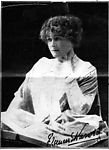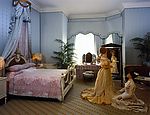The Countess of Warwick was invited to open a fund raising bazaar in Cradley Heath on Monday 5th February 1912. The proceeds of this, and a second bazaar held on the following day, were to be used to furnish the Workers' Institute, which was to open later that year. In introducing her, the Chairman, Mr John Fellows, recognised her dedication to good causes. He said, "that by her devotion to the cause of the people, by her identification with numerous public movements ... and by her sympathy and support of the women chainmakers, she had endeared herself to the nation. By her presence there that afternoon, she had added another link that bound her to their hearts." (County Express, 10th February 1912)
Lady Warwick had heard about the women chainmakers and their fight for a minimum wage from her friend, Mary Macarthur. In her speech she said that, "The chainmakers set the women workers of the country an example and all organised labour had been stirred. It showed that when they linked themselves together they could move mountains, whereas isolated efforts failed," and "in building the Institute they were making a start in the direction of education, without which they could not stand side by side with the governing classes." (Wolverhampton Chronicle, 7th February 1912)
The Countess of Warwick was born at 27, Berkeley Square, London, on the 10th December 1861. She was born Frances Evelyn Maynard, but was known as Daisy, the elder of two daughters of the Honorable Charles Maynard and his second wife, Blanche Adeliza Fitzroy. Charles was the eldest son and heir of Viscount Henry Maynard.
Daisy Maynard inherited the bulk of the Maynard estates worth £20,000 a year in rents alone, and 30,000 acres of land. Her wealth and her beauty meant that she was always sought after in marriage. Queen Victoria considered her a suitable bride for her youngest son, Prince Leopold, Duke of Albany. Daisy, however, married Leopold's aide-de-camp, Francis Greville, Lord Brooke, heir to the earldom of Warwick, on 30th April 1881, in Westminster Abbey. She and her husband were members of the "Marlborough House Set", the "faster" set of London society, headed by the Prince of Wales.
In September 1881 Daisy gave birth to a son, and three years later a daughter. The following year a second son was born, but survived for a very short time. Another son, Maynard, was born in 1898, and her second daughter was born in 1904, when she was 42.
Late in 1886 Daisy began an affair with Lord Charles Beresford. A society scandal followed Lady Beresford's discovery of the affair. Daisy brought the Prince of Wales into the matter to ensure she did not suffer social ostracism. She became the Prince's lover, supplanting Lily Langtry.
The Beresford affair blew up again in 1891. The subsequent public scandal badly tarnished Daisy's reputation, although the Prince of Wales stood by her. Her marriage survived a number of infidelities. Her husband succeeded his father as fifth Earl of Warwick in 1893.
Lady Warwick, as she now was, by this time had a life that was a curious mixture of philandering and philanthropy. Like most women of her class, she took seriously her responsibilities towards the poor on her estates and gave generously in personal charity. She set up a series of institutions, including a needlework school for girls and young women who were unable to get into domestic service. The school, and the London shop set up as an outlet for the work, was heavily subsidized from her own pocket, as were many of her other enterprizes.She founded Bigods School, near Dunmow in Essex, in 1897, to provide co-educational agricultural and technical education for middle class children.
Lady Warwick had also developed an interest in Socialism. She was concerned about conditions, especially for the rural poor, and was elected poor law guardian for Warwick. Her earlier efforts to relieve some of the poverty would probably be considered patronising today. She held a spectacular fancy dress ball at Warwick Castle in 1895, which provided work for many dressmakers, milliners, caterers and other staff. There were those ready to criticize at the time. The Clarion, a socialist paper reported, "thousands of pounds spent on a silly masquerade; men and women strutting before each other's envious eyes in mad rivalry of wanton dissipation; lavish luxury on lavish luxury, heap on heap, glitter on glitter, in a vulgar saturnalia of gaudy pride, that displayed a callousness that mocks and laughs at misery." (The Clarion, 16th February 1895)
Lady Warwick was shocked and angered, and took the next train to London to confront Robert Blatchford, the editor of The Clarion. The lecture she received from him marked a new path for her. She became interested in trade unionism, entertained trade unionists at Warwick Castle, and made public speeches in their support.
In 1898 she set up a hostel for Women in Reading, which in 1903 moved to Studley Castle in Warwickshire, where it became known as Studley Agricultural College for Women. It survived until 1969. She employed men from the Salvation Army colony to work on her redesigned gardens at Easton. She attended The International Congress of Socialists in Amsterdam in 1904, and later that year joined the Social Democratic Federation. In February 1905, at Keir Hardy's request, she attended a Labour meeting in Grimsby, prior to the general election. She was a Labour candidate for Walthamstow East in 1920, but withdrew, and in 1923 she stood for Labour in Leamington, but came third in the poll.
In many respects, Lady Warwick was the original champagne socialist, mingling socialist theory and political campaigning with country house parties and charitable work, but her life-style and generosity continued beyond her means. She became encumbered by debt, and took to writing in order to generate some income. Desperate financial circumstances led her to try to publish her memoirs, including intimate letters from the Prince of Wales. The King, George V, took out an injunction to prevent them being published, and secured their destruction.
Lady Warwick survived her husband by 15 years. She died at Easton Lodge on 26th July 1938. She bequeathed property worth just £37,000 to her surviving son, Maynard, a mere fraction of the wealth she inherited in 1865.
Rollover the captions in the box to see the available images in thumbnail format, click the caption to see the full-size image
| Reference: | 700 |
| Keywords: | |
| Archive Ref: | |
| Updated: | Thu 12 Jul 2007 - 0 |
| Interpretation written by | Barbara Harris |
| Author's organisation | |
| Organisation's website |

